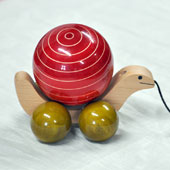Design Resource
Channapatna Toy II
The Craft of Wooden Toys
by
- The process of making a toy starts from the procurement of raw material, which is sourced from the local wood suppliers and then it is seasoned for 1-3 months depending on the size of the planks. Though the government supplier supply seasoned wood but to achieve cost effectiveness the artisans prefer to buy the wood locally and season them at home itself.
- The seasoned wood is cut in different sizes according to the need. These small pieces
are mounted on lathe machine and with the help of different types of chisel the wood is shaped in spherical, circular or oval sahpesas per the design.
- The form is then rubbed with a sand paper in order to smoothen the surface.
- Once the wood is shaped in desired form the lacquering process starts. The artisans press the lacquer stick against the wooden piece while it is still on lathe and due to the heat produced by friction lacquer gets applied on the wood.
- The applied lacquer is spread uniformly over the surface with the help of dried palm leaf. This also gives shine and luster to the product.
- For measuring the size and maintaining the precision, artisans frequently use Varner caliper and divider.
- Once the product is made it is detached from the lathe and further surface embellishment or assembling of different parts (if the toy is made of 2 or more parts)
is done. Other decorative works on the surface of toy are also done at this stage



































